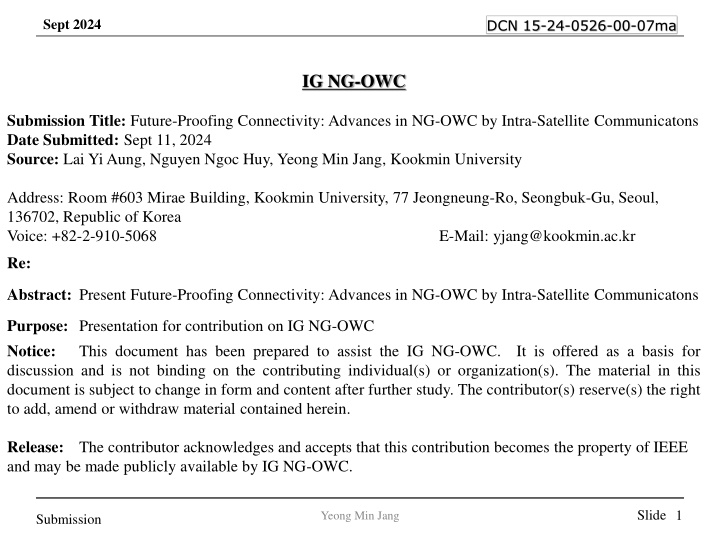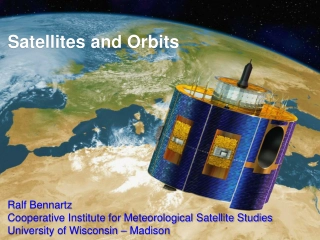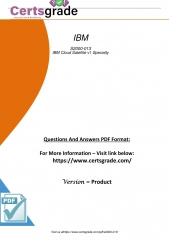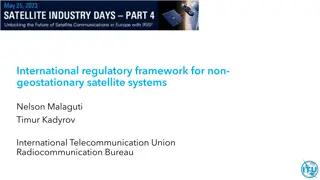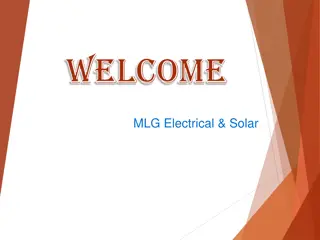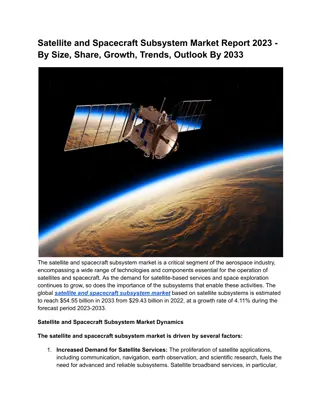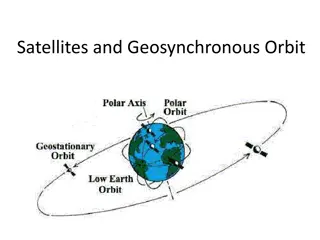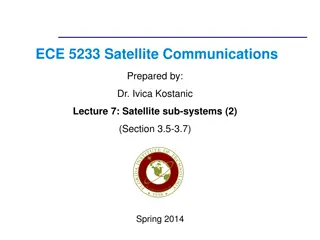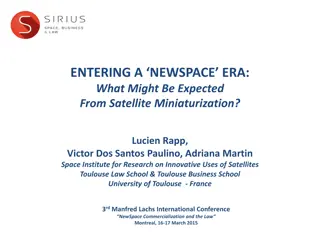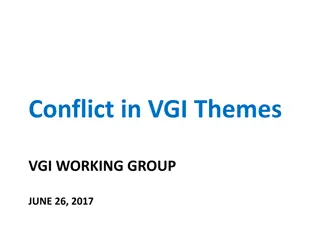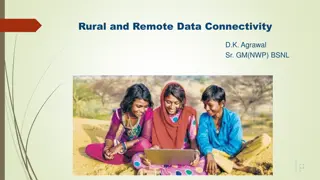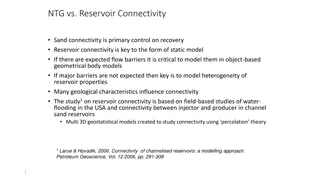Advances in NG-OWC: Future-Proofing Connectivity Through Intra-Satellite Communications
The evolution of satellite communication systems for global connectivity and high-speed data transmission is propelled by Next-Generation Optical Wireless Communication (NG-OWC). Intra-satellite communication advancements using technologies like Optical Camera Communication (OCC), Spatial Division Multiple Access (SDMA), and Wavelength Division Multiplexing (WDM) enhance network performance and capacity. This presentation explores the transformative capabilities of NG-OWC in meeting the escalating demands of modern communication networks.
Download Presentation

Please find below an Image/Link to download the presentation.
The content on the website is provided AS IS for your information and personal use only. It may not be sold, licensed, or shared on other websites without obtaining consent from the author.If you encounter any issues during the download, it is possible that the publisher has removed the file from their server.
You are allowed to download the files provided on this website for personal or commercial use, subject to the condition that they are used lawfully. All files are the property of their respective owners.
The content on the website is provided AS IS for your information and personal use only. It may not be sold, licensed, or shared on other websites without obtaining consent from the author.
E N D
Presentation Transcript
Sept 2024 DCN 15-24-0526-00-07ma IG NG-OWC Submission Title: Future-Proofing Connectivity: Advances in NG-OWC by Intra-Satellite Communicatons Date Submitted: Sept 11, 2024 Source: Lai Yi Aung, Nguyen Ngoc Huy, Yeong Min Jang, Kookmin University Address: Room #603 Mirae Building, Kookmin University, 77 Jeongneung-Ro, Seongbuk-Gu, Seoul, 136702, Republic of Korea Voice: +82-2-910-5068 E-Mail: yjang@kookmin.ac.kr Re: Abstract: Present Future-Proofing Connectivity: Advances in NG-OWC by Intra-Satellite Communicatons Purpose: Presentation for contribution on IG NG-OWC Notice: This document has been prepared to assist the IG NG-OWC. It is offered as a basis for discussion and is not binding on the contributing individual(s) or organization(s). The material in this document is subject to change in form and content after further study. The contributor(s) reserve(s) the right to add, amend or withdraw material contained herein. Release: The contributor acknowledges and accepts that this contribution becomes the property of IEEE and may be made publicly available by IG NG-OWC. Slide 1 Yeong Min Jang Submission
Sept 2024 DCN 15-24-0526-00-07ma Future-Proofing Connectivity: Advances in NG-OWC by Intra-Satellite Communications Contribution Sept 11, 2024 Slide 2 Yeong Min Jang Submission
Sept 2024 DCN 15-24-0526-00-07ma Contents Background Intra-Satellite OCC Framework Spatial Division Multiple Access(SDMA) Wavelength Division Multiplexing(WDM) Challenges Conclusion References Slide 3 Yeong Min Jang Submission
Sept 2024 DCN 15-24-0526-00-07ma Background The evolution of satellite communication systems is critical to meeting the growing demands for global connectivity, high-speed data transmission, and robust network performance. As the users advance into an era characterized by increasing data requirements and complex communication networks, Next-Generation Optical Wireless Communication (NG-OWC) emerges as a transformative technology, particularly for intra-satellite communications. Slide 4 Yeong Min Jang Submission
Sept 2024 DCN 15-24-0526-00-07ma Intra-Satellite OCC Framework Optical Camera Communication(OCC) is an extension of the Visible Light Communications (VLC) technology. In intra-satellite environments, OCC systems can enhance communication between satellite devices due to their electromagnetic robustness and reduced size and weight. Spatial Division Multiple Access (SDMA) The users go over a few more features of the OCC technology that make it particularly appropriate for the intra-satellite environment in this section. Slide 5 Yeong Min Jang Submission
Sept 2024 DCN 15-24-0526-00-07ma Cont d The convergence of SDMA, Wavelength division multiplexing(WDM), and OCC offers a powerful solution for advancing optical wireless communication systems. SDMA and WDM enhance capacity and efficiency, while OCC leverages optical cameras for high-speed, high-resolution data exchange. Fig. 2. SDMA and WDM combined. Fig. 1. OCC intra-satellite communication links examples. Slide 6 Yeong Min Jang Submission
Sept 2024 DCN 15-24-0526-00-07ma Challenges Alignment and Precision: The precision required for optical links in space is significantly higher than for RF links. Maintaining accurate alignment of optical beams over varying distances and conditions is crucial. Environmental Factors: Space environments pose unique challenges such as thermal extremes and micrometeoroid impacts that can affect optical systems. Power Consumption: Optical communication systems, particularly those involving high-power lasers, may have different power requirements compared to traditional RF systems. Slide 7 Yeong Min Jang Submission
Sept 2024 DCN 15-24-0526-00-07ma Conclusion NG-OWC represents a significant step forward in intra-satellite communications, offering the potential for high-speed, high-capacity data transmission that is essential for the next generation of satellite networks. As satellite technology progresses, the adoption of optical communication systems will be instrumental in meeting the growing demands for connectivity and data processing in space. By addressing current challenges and embracing future advancements, NG-OWC will help ensure that satellite communication systems remain at the forefront of technological innovation. Slide 8 Yeong Min Jang Submission
Sept 2024 DCN 15-24-0526-00-07ma References 1. J. Rabadan et al., "OCC Strategies for Intra-Satellite Communications - OCC4SAT Project," 2024 14th International Symposium on Communication Systems, Networks and Digital Signal Processing (CSNDSP), Rome, Italy, 10.1109/CSNDSP60683.2024.10636436. 2024, pp. 262-267, doi: 2. M. F. Ahmed, M. K. Hasan, M. Z. Chowdhury, N. C. Hoan and Y. M. Jang, "Continuous Status Monitoring of Industrial Valve Using OCC-Enabled Wireless Sensor Network," in IEEE Transactions on Instrumentation and Measurement, vol. 71, pp. 1-10, 2022, Art no. 5501010, doi: 10.1109/TIM.2021.3130292. 3. N. Van Hoa, H. Nguyen, C. H. Nguyen and Y. Min Jang, "OCC Technology-based Developing IoT Network," 2020 International Conference on Information and Communication Technology Convergence (ICTC), Jeju, Korea 10.1109/ICTC49870.2020.9289552. (South), 2020, pp. 670-673, doi: 4. A. Liu, W. Shi, M. Safari, W. Liu and J. Cao, "Design Guidelines for Optical Camera Communication Systems: A Tutorial," in IEEE Photonics Journal, vol. 16, no. 4, pp. 1-25, Aug. 2024, Art no. 7303025, doi: 10.1109/JPHOT.2024.3424885. Slide 9 Yeong Min Jang Submission
